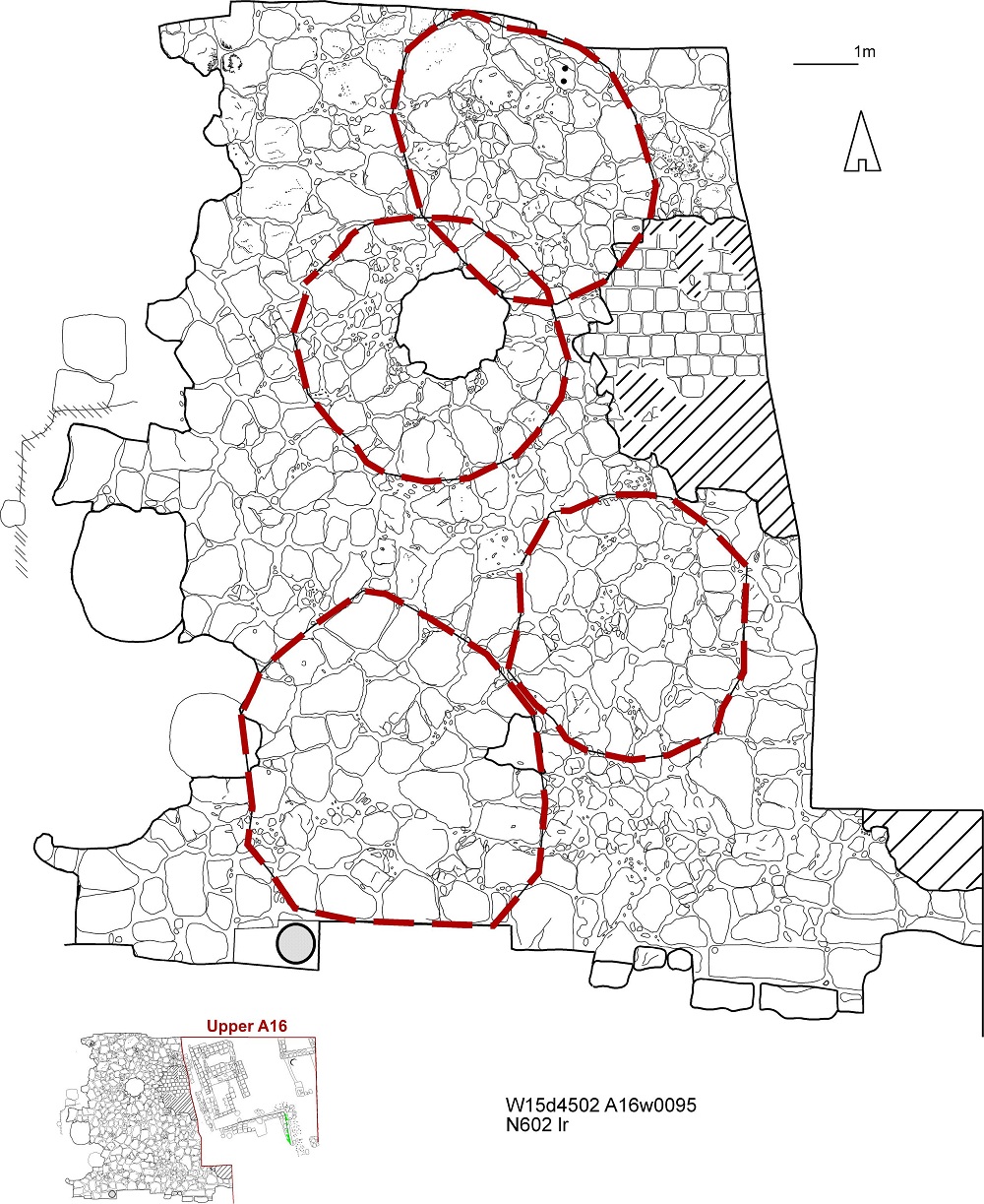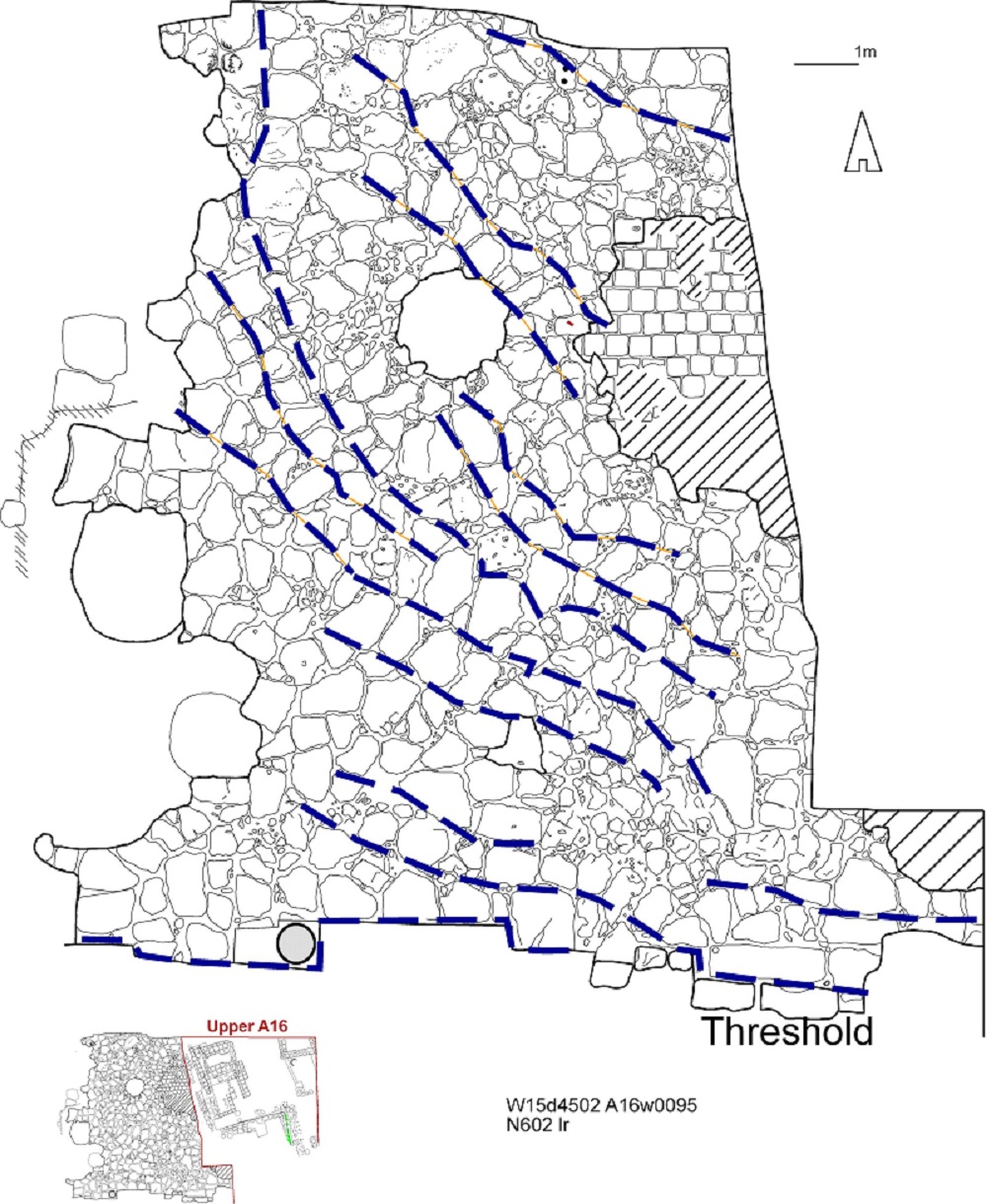Back to top: Depositional data for Unit A16 Construction
Pavements: the Palace courtyard
 |

|
It seems difficult to distinguish an unequivocal pattern that might have been used in laying down the stones. As excavations progress and more of the surface of the pavement is exposed, it is possible that a clear answer may emerge. For now, two alternatives seem possible.
The first (in red) would consist of concentric patterns laid one next to the other. This pattern, however, does not extend to the entire surface, and seems both less practical in execution and somewhat haphazard in planning.
The second alternative (in blue) seems preferable. In this case, we may surmise that construction started at the threshold (the southernmost row of stones is aligned with the wall and with the threshold itself), and then extended in a fan-like manner to the northeast – the east being presumably the place where an other entrance to the courtyard was located).
Back to top: Depositional data for Unit A16 Construction
Other pavements
Some pebble and sherd surfaces are found in the Khabur period strata. The best examples are f119, f144, f207, but they are not very well done and compact, with not that many elements, scattered on a wide surface. They are composed by pebbles and sherds, and are understood as street surfaces between burial installations. Compared to similar surfaces found in other A units (A18), they can not be considered well built.
Back to top: Depositional data for Unit A16 Construction
Floors
Many floors were uncovered in A16, both inside the various structures (graves, rooms) and outside in open and wider spaces. Floor f51 is plastered and well preserved, ant it seems associated with room a1 and with two complete Khabur jars. Below it there was another highly compacted but not plastered floor f62. Other plastered floors are f133, f140 (in burial a6) and f201. Compacted floor, not plastered are found mainly in open areas: f88, f92, f121, f125, f146, f159. They were probably formed by walking activities of people on these surfaces. Any material was intentionally added, except for sherds and pebbles in floor f159.
Back to top: Depositional data for Unit A16 Construction
Pits
Pits were excavated mainly in lower A16 levels. After the abandonment and the collapse of the palace the area was an open space, probably marginal to the settlement. In Phase 4 and in Phase 5 several pits were excavated, both as burials (f209, f217, f276) and trash pits (f250, f216). They are usually circular and quite regular, not very large in dimensions. Some of these pits cut only the reddish material a27, others (f216 and f250) cut the stone pavement (a12) of the courtyard and in that case they could even reach two meters deep. Some of them instead are very small and shallow (f273, f298, f299).
Back to top: Depositional data for Unit A16 Construction
Graves and rooms
Some mud brick structures were interpreted as graves. For others there are more doubts and their function is unclear, so they are labelled as rooms. These structures are usually small, without foundations. a1 is a eroded room with just few courses of mud bricks preserved. The walls are about two mud bricks wide and two supporting walls were added in a later moment. No brickfall was found inside the structure but only on top of it. The best preserved rooms are a6, a9 and a10. a6 and a9 were built-up structures with a vault for ceiling, and the walls one mud brick and an half wide. Both have a thick collapse from the ceiling inside. Tomb a9 was apparently built with one mud brick wide walls and a corridor. The structures seems to me related to a pit cut, while the excavators say, on the base of collapse typology, it was a vaulted structure and probably free standing. Unfortunately these structures, especially those next to the tell slope were highly eroded since antiquity. The others are not completely excavated.
Back to top: Depositional data for Unit A16 Construction